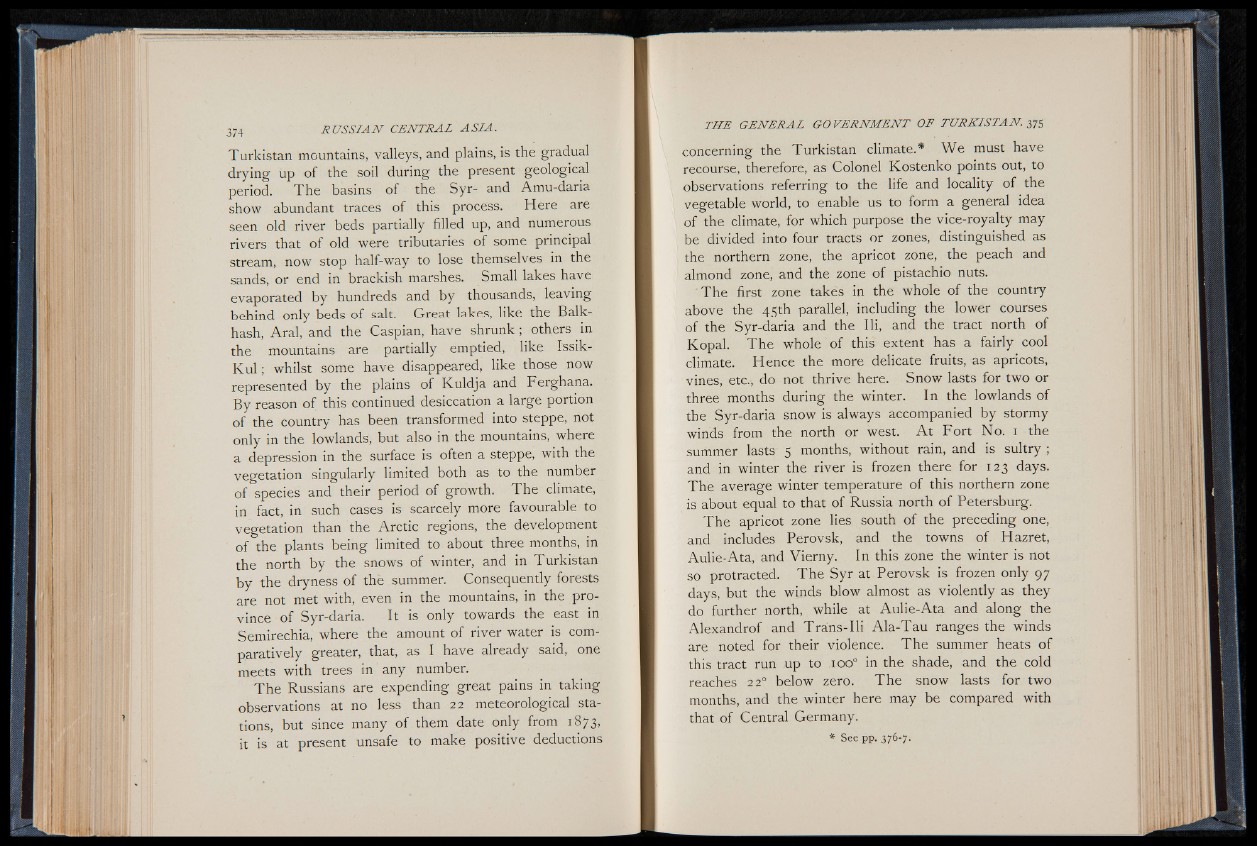
Turkistan mountains, valleys, and plains, is the gradual
drying up of the soil during the present geological
period. The basins of the Syr- and Amu-daria
show abundant traces of this process. Here are
seen old river beds partially filled up, and numerous
rivers that of old were tributaries of some principal
stream, now stop half-way to lose themselves in the
sands, or end in brackish marshes. Small lakes have
evaporated by hundreds and by thousands, leaving
behind only beds of salt. Great lakes, like the Balkhash,
Aral, and the Caspian, have shrunk ; others in
the mountains are partially emptied, like Issik-
Kul ; whilst some have disappeared, like those now
represented by the plains of Kuldja and Ferghana.
By reason of this continued desiccation a large portion
of the country has been transformed into steppe, not
only in the lowlands, but also in the mountains, where
a depression in the surface is often a steppe, with the
vegetation singularly limited both as to the number
of species and their period of growth. The climate,
in fact, in such cases is scarcely more favourable to
vegetation than the Arctic regions, the development
of the plants being limited to about three months, in
the north by the snows of winter, and in Turkistan
by the dryness of thè summer. Consequently forests
are not met with, even in the mountains, in the province
of Syr-daria. It is only towards the east in
Semirechia, where the amount of river water is comparatively
greater, that, as I have already said, one
meets with trees in any number.
The Russians are expending great pains in taking
observations at no less than 22 meteorological stations,
but since many of them date only from 1873,
it is at present unsafe to make positive deductions
concerning the Turkistan climate.* We must have
recourse, therefore, as Colonel Kostenko points out, to
observations referring to the life and locality of the
vegetable world, to enable us to form a general idea
of the climate, for which purpose the vice-royalty may
be divided into four tracts or zones, distinguished as
the northern zone, the apricot zone, the peach and
almond zone, and the zone of pistachio nuts.
The first zone takes in the whole of the country
above the 45th parallel, including the lower courses
of the Syr-daria and the Hi, and the tract north of
Kopal. The whole of this extent has a fairly cool
climate. Hence the more delicate fruits, as apricots,
vines, etc., do not thrive here. Snow lasts for two or
three months during the winter. In the lowlands of
the Syr-daria snow is always accompanied by stormy
winds from the north or west. A t Fort No. 1 the
summer lasts 5 months, without rain, and is sultry ;
and in winter the river is frozen there for 123 days.
The average winter temperature of this northern zone
is about equal to that of Russia north of Petersburg.
The apricot zone lies south of the preceding one,
and includes Perovsk, and the towns of Hazret,
Aulie-Ata, and Vierny. In this zone the winter is not
so protracted. The Syr at Perovsk is frozen only 97
days, but the winds blow almost as violently as they
do further north, while at Aulie-Ata and along the
Alexandrof and Trans-Ili Ala-Tau ranges the winds
are noted for their violence. The summer heats of
this tract run up to ioo° in the shade, and the cold
reaches 220 below zero. The snow lasts for two
months, and the winter here may be compared with
that of Central Germany.
* See pp. 376-7.